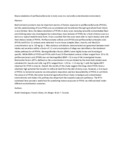| dc.contributor.author | Vestergren, Robin | |
| dc.contributor.author | Orata, Francis | |
| dc.contributor.author | Berger, Urs | |
| dc.contributor.author | Cousins, Ian T. | |
| dc.date.accessioned | 2021-06-09T07:10:22Z | |
| dc.date.available | 2021-06-09T07:10:22Z | |
| dc.date.issued | 2013-05-04 | |
| dc.identifier.uri | https://doi.org/10.1007/S11356-013-1722-X | |
| dc.identifier.uri | https://link.springer.com/article/10.1007/s11356-013-1722-x | |
| dc.identifier.uri | http://r-library.mmust.ac.ke/123456789/1659 | |
| dc.description.abstract | Beef and dairy products may be important vectors of human exposure to perfluoroalkyl acids (PFAAs), but the understanding of how PFAAs are accumulated and transferred through agricultural food chains is very limited. Here, the bioaccumulation of PFAAs in dairy cows receiving naturally contaminated feed and drinking water was investigated by conducting a mass balance of PFAAs for a herd of dairy cows in a barn on a typical Swedish dairy farm. It was assumed that the cows were able to reach steady state with their dietary intake of PFAAs. Perfluorooctane sulfonic acid (PFOS) and perfluoroalkyl carboxylic acids (PFCAs) with 8 to 12 carbons were detected in cow tissue samples (liver, muscle, and blood) at concentrations up to 130 ng kg−1. Mass balance calculations demonstrated an agreement between total intake and excretion within a factor of 1.5 and consumption of silage was identified as the dominant intake pathway for all PFAAs. Biomagnification factors (BMFs) were highly tissue and homologue specific. While BMFs of PFOS and PFCAs with 9 and 10 fluorinated carbons in liver ranged from 10 to 20, perfluorooctanoic acid (PFOA) was not biomagnified (BMF < 1) in any of the investigated tissues. Biotransfer factors (BTFs; defined as the concentration in tissue divided by the total daily intake) were calculated for muscle and milk. Log BTFs ranged from −1.95 to −1.15 day kg−1 with the highest BTF observed for PFOS in muscle. Overall, the results of this study suggest that long-chain PFAAs have a relatively high potential for transfer to milk and beef from the diet of dairy cows. However, a low input of PFAAs to terrestrial systems via atmospheric deposition and low bioavailability of PFAAs in soil limits the amount of PFAAs that enter terrestrial agricultural food chains in background contaminated environments and makes this pathway less important than aquatic exposure pathways. The BTFs estimated here provide a useful tool for predicting human exposure to PFAAs via milk and beef under different contamination scenarios. | en_US |
| dc.language.iso | en | en_US |
| dc.publisher | Environmental Science and Pollution Research | en_US |
| dc.subject | Bioaccumulation, perfluoroalkyl, acids, dairy ,cows, naturally, contaminated, environment. | en_US |
| dc.title | Bioaccumulation of perfluoroalkyl acids in dairy cows in a naturally contaminated environment. | en_US |
| dc.type | Article | en_US |

